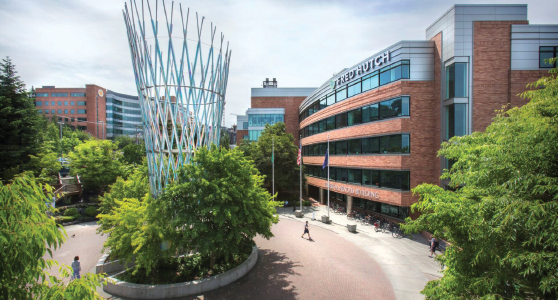In 2016, Filippo Milano, MD, PhD, Associate Professor, Translational Science and Therapeutics Division, and Director of the Cord Blood Transplant Program at Fred Hutchinson Cancer Center in Seattle, published the results of his landmark study investigating whether an alternative stem cell donor source found in umbilical cord blood is a feasible option for patients lacking a traditional donor match. In the study, Dr. Milano and his colleagues reviewed the outcomes of 582 patients with acute myeloid or lymphoid leukemia or myelodysplastic syndrome who had received a first allogeneic hematopoietic cell transplant from an unrelated donor at the cancer center.

Filippo Milano, MD, PhD
The data from the study suggested that among patients with pretransplantation measurable residual disease, the likelihood of overall survival after receipt of a transplant from a cord-blood donor was at least as favorable as that with human leukocyte antigen (HLA)-matched unrelated donors and better than that with HLA-mismatched unrelated donors in high-risk patients with acute leukemia or myelodysplastic syndrome.1
Because stem cells from the umbilical cord, which is considered medical waste once a child is born, are naive and less developed than adult stem cells, they don’t have to be “matched” as rigorously to a patient’s HLA type, explained Dr. Milano. Thus, stem cells provide patients with the potential of a life-saving therapy who otherwise wouldn’t be eligible for a transplant.
And although transplanted umbilical cord blood can be used to treat or cure more than 80 diseases, including leukemia—the most commonly treated disease—and lymphoma, as well as blood disorders such as sickle cell disease and thalassemia, only about 40,000 umbilical cord blood transplants have been performed worldwide.2 In the United States, more than half of all stem cell transplants from unrelated donors in children use cord blood.3
Since 2006, the Cord Blood Transplant Program at Fred Hutchinson Cancer Center has led pioneering research on alternative stem cell sources to cure blood cancers and other blood diseases when transitional donors are not available; it has performed more than 700 cord blood transplants in patients ranging in age from 6 months to 75 years old.4 The success of the program, now headed by Dr. Milano, has led to the establishment of an Endowed Chair in Cord Blood Research, with Dr. Milano as the first recipient.
“This endowed chair gives me some security and stability in continuing this important research,” said Dr. Milano. “But, more importantly, it is a sign of trust and belief in the research I’m doing. At my institution, we know that cord blood transplantation is useful for patients and necessary for good outcomes for patients who don’t have a conventional donor. To have this financial security during this time is priceless. Researchers are struggling to find funding. I know that I will have funding for many years to continue this research, which will help ensure that every patient has a donor.”
In this interview with The ASCO Post, Dr. Milano talked about the progress being made in cord blood transplantation; the advantages and disadvantages of this procedure; and the personal reward of seeing patients live a long, high-quality life in survivorship.
Understanding the Decline in Cord Blood Transplantation
Please talk about the advances made in umbilical cord blood transplantation in hematologic cancers since the results of your study a decade ago. Your study showed that the probability of overall survival among recipients of a cord blood donor was at least as favorable as those who received an HLA-matched unrelated donor and significantly higher than the probability after receipt of a transplant from an HLA-mismatched unrelated donor.
A lot has happened over the past 10 years in umbilical cord blood transplantation, but not all has been positive news. Despite the great results we showed in our study, in 2016, which have been replicated in more recent studies and was important to have other investigators report similar outcomes, the use of cord blood transplantation has been decreasing worldwide, especially in the United States and Europe. The reason is mostly due to the lack of expertise in umbilical cord blood transplantation in many transplant centers across the country. So, that’s definitely a sad outcome that I’m facing.
Providing Patients With a High-Quality Life After Cancer
Please talk about the advantages and disadvantages of cord blood transplantation compared with other types of hematopoietic cell transplantation in the treatment of blood cancers. What are some immediate and long-term side effects of cord blood transplantation?
All stem cell transplants—regardless of whether the stem cells are from a patient’s marrow or blood, a donor’s marrow, or donated cord blood—are difficult procedures for patients to undergo. In umbilical cord blood transplantation, because cord blood contains a lower cell dose, the amount we are able to engraft into a patient is small compared with the amount of stem cells from adult donors, which leads to a slower recovery of the immune and blood systems as well as an increase in infections. This may be another reason why cord blood transplantation is decreasing, because you need more supportive care against infection. This is a main disadvantage compared with other stem cell sources. However, if managed correctly, infection risk can be reduced, and patients can experience the benefits of this procedure.
With the right supportive care and infection prevention strategies, we can make sure patients tolerate this therapy [cord blood transplantation] well.— FILIPPO MILANO, MD, PhD
Tweet this quote
To prevent fungal, viral, and bacterial infections during delay in engraftment, we give patients antibiotic, antiviral, and antifungal prophylaxis. We are precise in putting together the right combination of prophylaxes for patients. We also use letermovir to prevent cytomegalovirus activation, which has been a huge advancement in the field. With the right supportive care and infection prevention strategies, we can make sure patients tolerate this therapy well.
A major advantage in cord blood transplantation is because the stem cells are from the umbilical cord and are less developed than adult stem cells, they have the capability of better adopting to the host. We found in our study that cord blood stem cells may be associated with a lower risk of relapse and chronic graft-vs-host-disease, which is critical for our patients.
We don’t just want to cure patients of their blood cancers. We want them to have a high quality of life after their transplant. We want to give patients back the life they had before cancer.
Using a Third-Party Donor in Cord Blood Transplantation
Your recent phase II study investigated the addition of dilanubicel, an off-the-shelf cellular therapy used for improving outcomes for patients undergoing allogeneic transplantation and for patients with acute myeloid leukemia, to remove the need for a second cord blood unit and to enhance graft-vs-leukemia. You found that combining dilanubicel with a matched cord blood unit led to 14 patients in the trial having a successful transplant with minimal side effects.5 What’s next in this study?
This has been the most outstanding result for patients. Basically, we are developing a platform in which a single cord blood transplant is augmented with dilanubicel as a third-party donor transient graft to make the transplant safer and more effective for patients.
This phase II study initially included 14 patients and later grew to 28 patients. With a median follow-up of more than 12 months, 27 patients are alive and in remission. Only one case of relapse and transplant-related mortality has been reported. Of note, infusion of dilanubicel was not associated with increased graft-vs-host disease, and, remarkably, no instances of grade III or IV graft-vs-host disease and chronic graft-vs-host disease were observed.

Also, 40% of the patients in this study were ethnic minorities. We want all patients to be able to benefit from advances in cancer, so it was very rewarding to see how well minority patients did in the study.
All of the patients in this study had acute leukemias, and nearly all of them are still doing well, more than a year later, which is significant. We were able to increase the number of patients in the study thanks to a $50,000 grant from one of my young patients, who wanted to help others have the same chance she had for a potential cure. She is now in college and living her life.
This is the beauty of my job. Sometimes I get discouraged and frustrated; then I see study results like these and say, okay, now I understand why I’m doing what I’m doing. It’s very rewarding.
DISCLOSURE: Dr. Milano reported no conflicts of interest.
REFERENCES
1. Milano F, Gooley T, Wood B, et al: Cord-blood transplantation in patients with minimal residual disease. N Engl J Med 375:944-953, 2016.
2. Devi S, Bongale AM, Tefera MA, et al: Fresh umbilical cord blood—A source of multipotent stem cells, collection, banking, cryopreservation, and ethical concerns. Life (Basel) 13:1794, 2023.
3. National Cord Blood Network: Welcome to the National Cord Blood Network. Available at https://www.cordbloodnetwork.org/. Accessed October 21, 2025.
4. Fred Hutch Cancer Center: Cord Blood Transplant Program. Available at www.fredhutch.org/en/research/divisions/translational-science-and-therapeutics-division/cord-blood-transplant-program.html. Accessed October 21, 2025.
5. Milano F, Dahlberg A, Roberts LC, et al: Dilanubicel, a non-HLA-matched pooled universal product, transforming single cord blood transplantation success rates. Blood 144(suppl 1):377, 2024.

